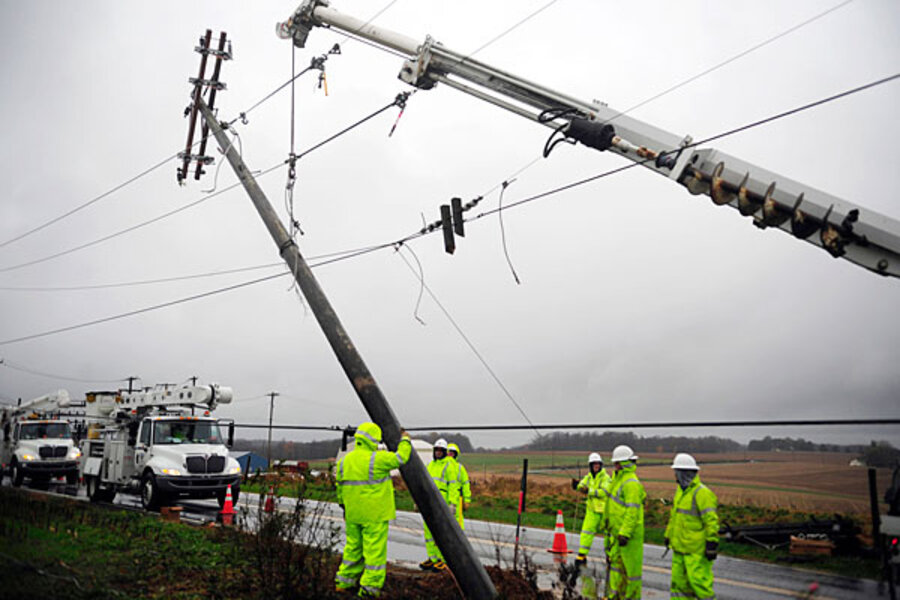Hurricane Sandy power outages: signs of progress in some states
Loading...
| Boston
Power is being restored faster in the aftermath of hurricane Sandy than it was after hurricane Irene, suggesting that utilities learned some lessons from last year’s storm and may have been better prepared this time.
In terms of power outages, hurricane Sandy and Irene were similar. Sandy knocked out power to 8.2 million customers across 20 states, while Irene left 8.4 million customers in the dark in 13 states, according to the Department of Energy (DOE).
But the rate at which power is being restored this week tops power companies’ efforts after Irene. Among the 12 states that experienced both hurricanes, an average of 1 million customers per day got their power back after Irene. In Sandy's aftermath, that number has ticked upward to 1.2 million.
Within that improvement, though, there is wide variation. Utilities in some of the states hardest-hit by Sandy – including New York and Maryland – are restoring power at a slower rate than they did last year. While others – including Massachusetts, Connecticut, and Delaware – are doing better.
Utilities in New Jersey, which received the brunt of Sandy’s force, are the nation’s top performers. As of 3 p.m. Wednesday, power was being restored a rate of 313,000 customers per day – compared with a 147,000 per-day rate after Irene.
Clearly, power crews have more to do in New Jersey now than they did after Irene, which could explain some of the figures. Moreover, many factors – such as the degree of flooding, the volume of downed tree limbs, and the types of outages – make comparisons difficult.
But experts say utilities and the government officials charged with overseeing emergency response have also been making changes during the past year.
Since hurricane Irene, utilities have put more money put into grid infrastructure, says Alan Rubin, a partner at the law firm of Cozen O’Connor, who coordinated recovery efforts following Hurricane Andrew in 1992.
In addition, the government is “more hands on," he says. "I know that this time there have been government officials in some control rooms of some utilities that have been problem children in the past – just to make sure the information they're getting isn't stale and secondhand."
Communication between federal, state, and local emergency managers has been very good, agrees Mark Merritt, president of Witt Associates, a Washington consulting firm that conducts post-hurricane response analyses for governments.
"I hope it all continues to go well,” he says. “If it doesn't, it's going to become very public very quickly."
The slower rates of power restoration in some states do not necessarily point to negligence on utilities’ part, observers add. The flooding in New York City could make restoration of power there particularly complex and slower than many hoped, despite preparations by utility companies. The state’s current 83,000 per-day restoration rate lags its effort after Irene by 42,000, the DOE data show.
Other areas, though, show signs of progress from last year.
Connecticut made the controversial decision temporarily to ban travel on highways, but experts say it has helped. Connecticut Light and Power and the state government have been under pressure to perform better then they did after Irene, when some outages lasted weeks. So far, Connecticut is restoring 69,000 customers per day compared with 61,000 per day last year.
"Irene was a big wake up call in terms of paying attention to electrical and other infrastructure," says Mr. Rubin of Cozen O’Connor. "The government and utilities in Connecticut have done a very good job. Last year they were hit with Irene and then that snowstorm, so they've had experience. This time they shut down the highways to get the power trucks where they needed to go. It was a brilliant move.”







